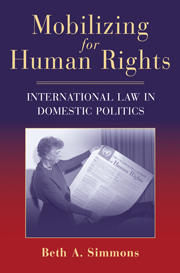Book contents
- Frontmatter
- Contents
- List of Figures and Tables
- Acknowledgments
- Abbreviations
- Part I
- Part II
- 5 Civil Rights
- 6 Equality for Women: Education, Work, and Reproductive Rights
- 7 Humane Treatment: The Prevalence and Prevention of Torture
- 8 The Protection of Innocents: Rights of the Child
- 9 Conclusion
- Appendix 1 Data Appendix
- Appendix 2 Regime Type and Rule of Law Categories
- References
- Index
8 - The Protection of Innocents: Rights of the Child
Published online by Cambridge University Press: 05 June 2012
- Frontmatter
- Contents
- List of Figures and Tables
- Acknowledgments
- Abbreviations
- Part I
- Part II
- 5 Civil Rights
- 6 Equality for Women: Education, Work, and Reproductive Rights
- 7 Humane Treatment: The Prevalence and Prevention of Torture
- 8 The Protection of Innocents: Rights of the Child
- 9 Conclusion
- Appendix 1 Data Appendix
- Appendix 2 Regime Type and Rule of Law Categories
- References
- Index
Summary
[W]e do what we do in the realm of international organization because we strive, in our own fashion, to give expression to universal truths. What might these be in so contested an arena as international affairs? I believe that they include the truths of human dignity and fundamental equality, whereby a child born in the smallest village of the poorest land is valued as much as one born on Beacon Hill.
Kofi A. Annan, commencement address, Massachusetts Institute of Technology, 1997Modern society has recently recognized the need for special protections for children, and many of these have become enshrined in international legal agreements. The politics of children's rights protection differs from that of adults, because children typically require advocates willing to articulate and press their interests. International law can play an important role in advocacy on behalf of children. One of the most important things international law can do is to provide a rights-based framework at least to supplement the protective framework that has a much longer history in many societies and their constitutions. Moreover, it can provide a lever to give their would-be advocates influence over policies likely to have an important impact on the well-being of those who are not able to organize and speak for themselves.
This chapter explores the extent to which the Convention on the Rights of the Child (CRC) and its Optional Protocol Relating to Children in Armed Conflict (OPCAC) have been important in improving the lot of the world's children.
- Type
- Chapter
- Information
- Mobilizing for Human RightsInternational Law in Domestic Politics, pp. 307 - 348Publisher: Cambridge University PressPrint publication year: 2009



